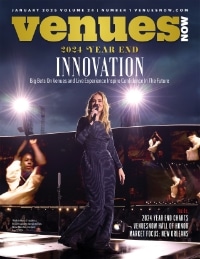SPEAK UP: Kim Stone, Washington Spirit; Joan Cronan, University of Tennessee’ Amy Scheer, Professional Women’s Hockey League; and Courtney Carter, Seattle Sounders/Reign. (OVG photo)
PHOENIX, Arizona — Women’s athletics is ready to un-tarp the upper tier.
During a packed panel during at the 2024 VenuesNow Conference in Phoenix, industry stakeholders discussed the state and future of women’s professional and amateur/college sports including a surge in viewership and attendance, investment and league expansion, sponsorships, branded content and fan engagement.
Moderated by Kim Stone, CEO of the Washington Spirit of the National Women’s Soccer League, the panel included Courtney Carter, chief revenue officer for the MLS Seattle Sounders FC and WSL Seattle Reign FC, Amy Scheer, senior vice president of business operations for the Professional Women’s Hockey League, and industry icon Joan Cronan, athletic director emeritus of the University of Tennessee.
Stone launched the conversation with industry figures including the unprecedented 18.9 million viewers who watched the NCAA Women’s Basketball Championship — the most ever on an ESPN platform; 9 million people who tuned in for the women’s soccer gold medal match at the Paris Olympics; and the $200 million TV contract for the Women’s National Basketball Association, a 51 percent increase year-over-year in value.
“All of these numbers, if this doesn’t tell you that this is not a moment, this is definitely a movement and something that is worth investing in,” said Stone. “We are finally seeing the investment match the interest.”
Cronan, who knew she wanted to be in charge of an athletic program when they wouldn’t let her play little league baseball as a young girl, added, “I’d like to ask you, ‘Is this a moment or is this momentum?’ I think it’s both.”
Since Title IX passed in 1972, women’s athletics have had opportunities to shine including Billie Jean King’s famous win in the Battle of the Sexes against Bobby Riggs in 1973 and the success of women’s soccer in the World Cup and Olympics. But what stuck with Cronan were the women in the stands.
“Ninety-four percent of women who sit in seat chairs, participate in sports,” said Cronan. “Ninety-one [percent] say playing sports helped them. Eighty-eight say, if they’re on a board, that what they learned on the field helped them. So, you’re not just developing opportunities for women to compete, what we are doing is developing women to be leaders.”
Those seats are filling up. Stone shared that a recent Washington Spirits game at Audi Field had an attendance of 13,700. At the same time, an NBA’s Los Angeles Clippers game hosted 13,400 at the Intuit Dome.
“If these are the benchmarks for sports, we’re already hitting them in terms of women’s sports,” explained Stone. “It’s now time, and I think people are starting to recognize the value that is there.”
Heading into its second season, Scheer discussed the strategies the PWHL deployed to differentiate the league including changing rules to putting games on YouTube to build the global audience and the decision to not name the teams.
“There was a lot of criticism,” admitted Scheer. “But better to take your time and come out with six great team names than to come out with team names that aren’t good or don’t have stories.”
Controlling all the teams under a single business umbrella had its advantages including controlling all the inventory and assets when talking to potential sponsors.
“So, we weren’t afraid to take over the game. We weren’t afraid to take over the business model. And I think also being a single entity allowed us to own all of assets on the sponsorship side,” shared Scheer.
With oversight of both men’s and women’s soccer in Seattle, Carter talked about the levels of scale in sponsorship and operational costs and efficiencies including dealing with the city and maximizing venue adaptability, including building stadiums specifically for women’s soccer.
“What I’m already seeing in a lot of these kind of stadium conversations, is the ability to flex,” explained Carter. “The ability to create a multi-use structure that doesn’t just house soccer but has soccer at its core. So, as you look at the future and entertainment in general, that’s what’s really important to us – creating spaces where people can create community and be entertained whether that’s a sport or something else.”
Flex isn’t just about adding seats. Carter said it is equally important to think about camera placement for broadcast opportunities AI technology.
Under Cronan’s leadership, the women’s basketball program at the University of Tennessee with coach Pat Summitt won eight national championships and made 18 trips to the NCAA Final Four, helping to pave the way for the success of NCAA women’s basketball.
Cronan offered her advice on building a powerful program, “You win, you win, you win.” she said. “I can remember Pat saying offense sells tickets, defense wins games, but rebounds win championships. But it takes fans and it takes people to make all that work and build a great team. And she was willing to work with me, to build a great audience for our arena.”
With the winter Olympics in Italy in 2025, Scheer is looking at ways to maximize the global platform to advance the sport of women’s hockey, especially with 53 Olympians on the roster. Mindful expansion of the league is also top of mind.
“We need to move past our six markets,” she said. “We need to grow across both countries and get off the east coast. When that happens? I’m not sure but it will be sooner than later. But it’s very important that we do it at a pace that the talented hockey players can keep up with us. What we don’t want to do at any point is hurt the product on the ice.”
Carter looks at sports under a broader the broader definition of entertainment with branded content a major player in the game of building brands around people and players.
“It’s a show, right?” said Carter. “You can do sports and entertainment all at once. You don’t have to sacrifice one for the other. It’s an ecosystem.”
Even as colleges and universities grapple with NIL, potential sponsor deals and the trend toward building multi-use entertainment districts around sports facilities, Cronan believes the role of venues as revenue generators is increasingly important.
“You know, when I think about the future, and I’m thinking about women’s basketball in particular, right now, I can remember Pat coming in with some of these wild ideas,” recalled Cronan. “We can play on a ship. We can play back-to-back. And I would say, ‘Why?’ She would look at me and say, ‘It’s good for the game.’ We need to think about what’s good for the game.”








